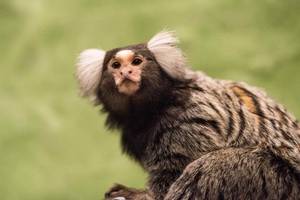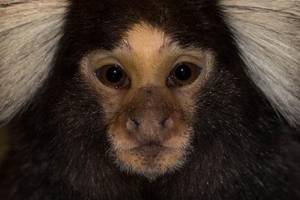News
16.01.2017
“Baby Talk“ in Marmoset Monkeys
Tübingen neuroscientists investigate the development of vocalisation in young monkeys
Tübingen neuroscientists have discovered that the young of common marmosets need their parents’ direct feedback to grow out of making infant noises. Raising a litter of monkeys apart from their parents, they found that, while these young animals eventually developed the innate vocalisations of adult monkeys, they still mixed it with typical infant vocalisations.
Sometimes, a happy coincidence can play a major role in science. From Alexander Fleming’s penicillin to Roy Plunkett’s teflon – some of modernity’s most important inventions have their root in chance making history. The researcher’s role in this case is to spot the remarkable coincidence and its extraordinary potential, to understand it, and to describe it scientifically.
This is what happened at Dr. Steffen Hage’s research group at the Tübingen Werner Reichardt Centre for Integrative Neuroscience (CIN): the main focus of the scientists is to investigate vocal motor production and cognitive control mechanisms in the brain. To this end, they also conduct behavioural experiments with marmoset monkeys. These animals, barely larger than a squirrel, are especially suited for this kind of research, since they are a loquacious species that communicates with their fellows in a complex manner.
One of the marmoset couples had a litter of three infants, one of which the parents rejected. Since common marmosets usually give birth to twins, and parents are not able to fully care for three young in most cases, it is quite common that the third infant is rejected by its parents. This third animal was hand-raised by an animal caretaker at the CIN. However, marmosets are communal animals that need stable social groups. Therefore the researchers wanted to reunite the rejected infant with its siblings as soon as possible. When after three months’ time the young remaining with their parents had been weaned, they were separated from their parents unusually soon, in order to bring the three monkey siblings together again. The resulting social group has proven stable. By now, the animals are fully grown up.
After a few weeks had passed, Yasemin Gültekin, a PhD student from Hage’s team, noticed an interesting peculiarity: the three siblings still made typical baby monkey noises, so-called “babbling”. Normally, marmosets only show this vocal behaviour during the very first months after birth. At first the researchers assumed they would grow out of it, but even while the siblings added adult calls to their repertoire, the rapidly growing monkeys retained the “babbling”, too. They still employ both now, as Gültekin & Hage’s detailed records show. Hage concludes that “apparently, the animals need direct social or acoustic feedback from their parents for normal development of their vocal behaviour”.
Hage’s team had in fact been expecting marmoset vocalisation to be completely innate, i.e. the basic pattern of calls usually develops without acoustic feedback. Intrigued, the neuroscientists in-vestigated further. When the parent monkeys had offspring a second time –twins this time –, they quickly brought their microphones to bear. The second litter, which, as is the usual practice, were kept with the parents far longer than three months, developed vocalisations according to what the researchers had expected in marmosets. At about seven months of age, they showed no infant vocalisations anymore, only adult call types. Comparing the total of almost 14,000 individual calls on record for the five siblings, there is conclusive evidence: while marmosets may not learn twittering, pheeing and peeping from their parents, they apparently do learn what you can “say” when and where as an adult.
Hage and his team are very happy with their results: “The vocal behavior of marmosets is different from that of humans or e.g. songbirds, since monkeys are not capable of learning new acoustic structures. However, it seems that developing the repertoire available to them heavily depends on direct feedback mechanisms much like our own. These animals are a compelling model system to investigate such early vocal development in humans. We can therefore learn a lot about early vocal development in humans from these animals.”
Publication:
Yasemin B. Gultekin, Steffen R. Hage (2016): Limiting Parental Feedback Disrupts Vocal Develop-ment in Marmoset Monkeys. Nature Communications 7: 14046.
Contact the author:
steffen.hage[at]cin.uni-tuebingen.de
Press contact CIN:
Dr. Paul Töbelmann
Science Communication and Public Outreach
Werner Reichardt Centre for Integrative Neuroscience (CIN)
Otfried-Müller-Str. 25
72076 Tübingen
Tel.: +49 7071 29-89108
<link>paul.toebelmann@cin.uni-tuebingen.de
<link http: www.cin.uni-tuebingen.de>www.cin.uni-tuebingen.de
 | Adult marmoset. Photo: Roland Hilgartner/University of Tübingen |
 |
